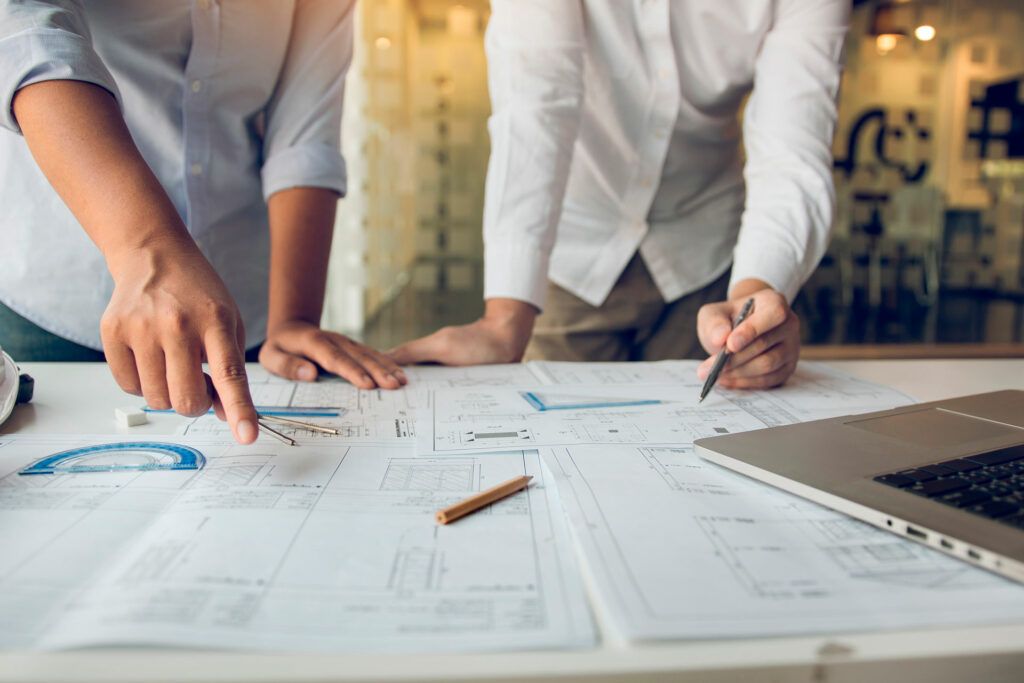To the untrained eye, the elaborate sketches and design ideas put together by an architect can be completely mind-boggling. But in order for an idea to become a reality, it needs to go through the stages of planning and building drawings to be able to explore a thought through visual communication.
Why are planning drawings important?
Planning drawings are a tool available to architects to explore innovation, bringing ideas to life in a logical way.
A simple sketch is far easier to comprehend than an idea communicated completely through words.
Not just a way to communicate, planning drawings also help bring to life genuine factors of the project that may need to be considered, such as light, texture, and perspective.
Most architectural design projects start with a simplistic drawing and work up to a complex and highly technical piece of work.
A key element to architectural drawings is to document a process and the evolution of an idea, for example a house extension or loft conversion. The individual steps taken throughout the project show the unique pathway in which the final project idea was formed.
The skill, experience, and precision in an architect’s drawings are used to convey the project dimensions and scale to a planning officer, so the overall application for the work is approved.
If your project requires planning consent drawings, MyHousePlan can provide professional planning and building drawings, creating your project aspiration for planning submission to achieve planning consent.
We know the planning system here in the UK can be complicated with new and changing policies and regulations added frequently. Our team are always up to date with the latest changes, which is reflected in the intricacy of our service.
Types of architectural drawings:
- Site Location Plan: A map base to show the location of the site in relation to neighbouring land, buildings, or roads. Often used to give an idea of the density of an area, to help understand whether the new development or work is appropriate to the already existing surroundings.
- Site Layout Plan (Block Plan): A more detailed, in-scale, comprehensive layout of your particular site. Specifying what the proposed works will look like against the property boundary, neighbouring buildings, and nearby roads.
- Elevations: These are essential to planning applications as they are used to show what the building will look like from the outside before and after the proposed work is carried out.
- Floor Plans: Used to show the internal layout of the building. Usually, two sets of floorplans are required; one to show the existing layout, and one to show the layout after the proposed plans.
- Site Sections and Finished Floor/ Site Levels: If your proposal involves a significant change in ground levels, drawings should be submitted to show both the existing and finished levels of the proposed works. These drawings will show what kind of impact the proposed works will have on neighbouring developments.
- Street scene/ Context Plan: For works that will be near your property boundary, neighbouring boundary, will have a noticeable change in height, and/ or visible from the road such as new buildings or large extensions.
- Roof Plans: These drawings show the shape of the roof, especially when proposed works will change the shape or appearance of the roof. Details such as roofing materials and their location are often specified on the roof plan.
- Landscaping: Becoming more common for roof gardens and in areas of Green Belt land, landscaping drawings are sometimes a condition of the planning permission, considering the growing importance of green infrastructure and architecture.
- Joinery Drawings and Details: Work on listed buildings often needs to be carried out with certain aspects of the existing building remaining exactly the same. These drawings detail the fixtures and fittings that are to be replaced.
- Photomontages: Important to show the client and planner what the project will look like and how it fits in the nearby landscape. They give an idea of the project scale and size.
Planning drawings are a necessity
In short, planning drawings are used throughout the architect project process, and are vital to encourage growth and development of ideas to make your project unique in both design and bespoke to your needs. It allows new ideas and observations to be explored, to provide you with the project outcome of your dreams from a bungalow conversion to a side extension.
Following your initial design visit, planning drawings are the first step in a complex process to complete your building work. To submit your planning applications, you must have planning drawings ready to accompany the paperwork, this helps to visualise what is it you’re requesting permissions for.
Find out more about the next steps in the planning application process here.
Our architect team at MyHousePlan balance the creativity of your project with the latest regulations to ensure it remains achievable from a planning policy perspective. Throughout the project, our architect will guide you through the planning process to make sure that the planning drawing produced achieves consent.
Planning drawings with MyHousePlan
MyHousePlan provides affordable design and drawings services to achieve planning and building regulations consent throughout Essex, and surrounding areas. The team are specialists in architectural designs for loft conversion drawings, house extension drawings, summer house design, bungalow conversions, and more.
To start your project, contact us today or find out more about our Planning Drawings service here.
